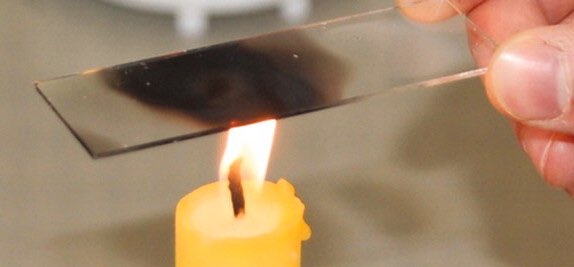Finishing Up
Removing Soot
Finishing Up
Removing Soot

What is soot?
Sometimes the fuel (candle wax) molecules don’t burn up completely. They clump together to form particles called soot, which then swirl around inside the body of the flame without actually burning. As they swirl, heat from the reaction zone can make this soot begin to glow a bright orange or yellow color. The reaction zone at the surface of the flame’s tent provides the blue color of the flame. The yellow color comes from hot soot, churning around inside.
Eventually this soot will probably enter the reaction zone and burn blue like the rest of the fuel. If the reaction zone is incomplete however, or not very efficient, the soot can escape the flame without burning at all. Outside the flame, the soot cools quickly to black and drifts away. What do we call this unburnt sooty fuel? Smoke.
So, essentially, soot is unburnt fuel or, in a way, smoke, that has been deposited on the surface of your egg, much as you can see it deposited on a glass slide here:

How does soot get deposited on a pysanka?
Soot deposits on an egg when it is held close to a flame. It can also be transferred form one’s fingers to an egg. This occurs most often when using a candle flame to remove beeswax from a pysanka, particularly in the hands of younger and less experienced pysankary.


When is Soot a Problem?
Soot is a problem when it makes your pysanka look dirty or grimy. Most eggs which have had the wax removed using a flame will have some soot deposition; you may not realize it is there until you actually clean the egg.
How do you get rid of soot?
Most light coatings of soot will be removed when you remove the residual wax. A bit of oil, vaseline or chemical solvent can also remove small amounts of soot.
If there is a lot of soot, is may be worthwhile to drip some candle wax (using open end of the the stylus reservoir or even the candle itself) onto this area. Let it cool, and then just heat and rub with the paper towel as you did before. The soot particles will dissolve in the wax and be removed when you remove the wax. You may have to repeat this a few times if the soot deposition is particularly heavy.
Solvents will help, too, but, in my experience (and as noted above), they are better used for small amounts of residual soot rather than large, dark depositions.
Back to Main Wax Removal page
Back to Main Pysankarstvo page
Removing the Last Bits of Grime
